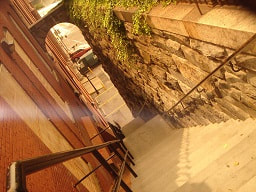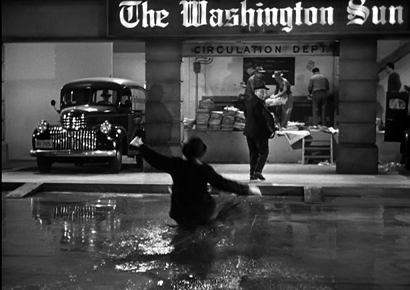|
Where and when was the actual "exorcism" case that William Blatty adapted into his Georgetown-set bestselling novel, The Exorcist (1971)?
PHOTO CREDIT: Lenka Reznicek, 2006. Reduced. Licensed under CC BY 2.5.
0 Comments
This detective’s-eye view of Washington, written by a former MPD (Metropolitan Police Department) officer, begins in the dead of winter. Detective Ezra Simeon, who does the narrating, has just been “detailed” (or relegated) to work in cold cases, having just contracted a case of stroke-like Bell’s Palsy. After being shifted again to homicide, he picks up a murder case involving some unlikely suspects and victims—a case which, in some of its details, closely resembles one of the cold murder cases he’s already worked on. As he gets nearer to the bottom of it, things take a startling, though not implausible, turn. On the way there we follow Ezra through the day-to-day of police work: the office politics and paperwork, the subway accidents and subpoenas and DNA tests, the cold calls and interviews, and the endless driving (sometimes with a partner) from station to diner to Judiciary Square to crime scene and back again. As a camera, Ezra works beautifully. The workmanlike writing and laconic style convey authenticity; so does Ezra’s perpetual, carefully detailed fatigue. But when we’re alone with him and his thoughts in his cruiser or his Chinatown mouse-hole—and Swinson spends a lot of ink characterizing him—there often doesn’t seem to be quite enough there. We know his father was a Secret Service agent and that he (Ezra) grew up in D.C. We know he’s divorced, and that back in California, through his ex, he’d been mixed up with the punk music scene. (The author’s own bio is similar.) Apart from whisky and cigars, his sole hobby—and the detectives are depicted as living their work—seems to be chatting and meeting with his L.A. friend, Clem. There’s a lot of transcript-like dialogue and interrogation, too, which gets across Ezra’s shrewdness, but he himself never fully comes across. And there’s perhaps too much elaborated-on slapping of alarm clocks, sipping of coffee, fighting of traffic, and logging into computers: the tedium of the job could have been got across in some more efficient way. Many readers will surely seek out this book, Swinson's first novel, which feels at times like a policeman’s diary, for its documentary aspects. Here it satisfies, with (among other things) up-close pictures of places like just-gentrifying Columbia Heights, Chinatown, and upper New York Avenue. There are few chronological cues—no TV shows, no movies, no period radio stations playing period Top 40. There’s an Xbox, though, and HDTV, and Adams Morgan (annoyingly Adam’s Morgan, every single time, in my Dymaxicon softcover) is already gentrified. All this puts the setting no later than the early 2000s, though, with those few cues, the story often feels as if it could be taking place at any point since 1991, the local end of the peak of the Great American Crime Wave, which was just starting to wane in the early 2000s. As people here never tire of saying, Washington (like most American cities) has changed a lot in twenty years. Along with giving us a readable story that only rarely bogs down, A Detailed Man captures that time when the Cool “Disco” Dan days had still not quite given way to Forbes Magazine’s redeveloped Cool D.C. PHOTO CREDIT: Tony Webster, 2018. Reduced. Licensed by CC BY 2.0. Last week we looked at the military population of the metro area. This time we'll look at some of the locally produced military publications:
First, there are the official products of Defense Media Activity (DMA), based at Fort Meade, MD. These include Airman, All Hands, defense.gov, army.mil, navy.mil, af.mil, and marines.mil. The best known is the editorially independent Stars and Stripes, with four overseas print dailies plus a domestic weekly; the successor of a Civil-War-era journal, it is produced at the National Press Building. The DC area's military academies and universities have their own publications: Prism and Joint Force Quarterly out of National Defense University at Fort McNair in Southwest; MCU Journal (Marine Corps University, Quantico); Defense Acquisition Magazine (Defense Acquisition University, Fort Belvoir, VA); Journal of Strategic Intelligence (National Intelligence University, Bethesda). The U S Naval Academy publishes Shipmate for alumni, and its midshipmen publish a “humorous periodical,” The Log. Then there are the journals, sometimes more than one, of the professional associations--of the US Naval Institute in Annapolis, the Marine Corps Association (Quantico), the Air Force Association (Arlington), the Association of the US Army (Arlington), and the Military Officers Association of America (Alexandria). The Army & Navy Club publishes The Dispatch. There’s also The Defense Monitor, published by the Project on Government Oversight (POGO). There are the several editions (Army, Navy, Air Force, Marine Corps) of Military Times, published by Sightline Media in the Virginia suburbs; Sightline also publishes Defense News and C4ISRNET. Finally, there are a host of locally produced commercial magazines devoted to military topics, like America’s Civil War Magazine (Leesburg), Small Wars Journal (Bethesda), and Vietnam Magazine (Vienna). Though this survey isn't complete, it hints at the scale of this local publishing sector, a lot of which accepts work from freelancers. Which American cities have the most writers? On the way to returning to tackling the question of how many writers there are in the DMV, let's first look at the same government data (the Occupational Employment Statistics) for some other cities (the cited tables, below, can be found about half way down the Bureau's page): 27-3043 Writers and Authors: Rank Metro area -- Employment (Employment per thousand jobs) 1 New York-Newark-Jersey City, NY-NJ-PA -- 7,490 (0.79) 2 Los Angeles-Long Beach-Anaheim, CA -- 4,680 (0.76) 3 Washington-Arlington-Alexandria... -- 2,230 (0.71) 4 Chicago-Naperville-Elgin, IL-IN-WI -- 1,770 (0.38) 5 Boston-Cambridge-Nashua, MA-NH -- 1,320 (0.48) 27-3022 Reporters and Correspondents: Rank Metro area -- Employment (Employment per thousand jobs) 1 New York-Newark-Jersey City, NY-NJ-PA -- 4,400 (0.46) 2 Washington-Arlington-Alexandria, DC... -- 2,120 (0.68) 3 Los Angeles-Long Beach-Anaheim, CA -- 1,460 (0.24) 4 Chicago-Naperville-Elgin, IL-IN-WI -- 850 (0.18) 5 San Francisco-Oakland-Hayward, CA -- 840 (0.35) 27-3042 Technical Writers: Rank Metro area -- Employment (Employment per thousand jobs) 1 Washington-Arlington-Alexandria, DC... -- 3,590 (1.15) 2 New York-Newark-Jersey City, NY-NJ-PA -- 3,230 (0.34) 3 Boston-Cambridge-Nashua, MA-NH -- 2,200 (0.80) 4 Dallas-Fort Worth-Arlington, TX -- 1,850 (0.52) 5 Los Angeles-Long Beach-Anaheim, CA -- 1,630 (0.27) It will surprise no one that, according to these data at any rate, the most professionally writery American cities are New York, Los Angeles, and Washington. (These OES data count only salaried professionals; they exclude the self-employed and the moonlighter.) The capital is a relatively good place to work as a salaried technical or professional writer. How a good a place is to be a struggling or not struggling novelist or a short-story writer or poet or a writer of commercial nonfiction? Does where you work on such things even matter, and if so, why? And supposing that Washington's a bad place to work on them, as some people say, why is that? To be continued... "The Snow Storm," writes Kim Roberts in her book A Literary Guide to Washington, DC (2018, Univ. of Virginia Press), "was DC's first race riot. It was begun in August 1835 with an alleged nighttime attack by Arthur Bowen, a nineteen-year-old slave, upon his owner, Anna Maria Thornton, aged sixty, widow of the architect of the Capitol, William Thornton."
Bowen was imprisoned. A mob of mostly Irish immigrant laborers tried to storm the jail, located on the site of present-day Judiciary Square, in order to hang him. The Mayor, District Marshal, and U S District Attorney (as U S Attorneys were then called) worked to pacify the mob; when their efforts failed, Marines were sent to guard the jail. The mob then went off and burned or damaged a number of churches, schools, homes, and businesses run by or for blacks-- including a restaurant run by a certain Mr. Snow (thus the "Snow Storm"). Here's a contemporary diarist's account of the events: "The 7 of August 1835 on friday it was reported that Mrs Doctor Thornton young Mulatto man said that he was going to knock his mistress in the head with axe and he were arrested and put in the Jail still the mob raged with great vigor and as fast as they were arrested they were lodged in Jail on the 8 day of August 1835 on saturday the mob surrounded the Jail and swear they would pull the Jail down and the Constable makin threats they said their objects was to get Mrs Thortons Mullateto man out and to hang him with out Judge or juror and evry effort was made by the Marshal of the District and the united States District Artoneny lawer Frances key Sr and the Hon Wiliam A Bradly that wher Mayo[r] of washington at that time evry efert wher made by the oficers to preserve peace and harmony among these men but all of it appeard in vain and they wher not surfichient Milertary force to guard the Jail..." The Attorney? Francis Scott Key, author of the words to "The Star-Spangled Banner." The diarist? Michael G. Shiner, a former slave, freed in 1836, who worked at the Navy Yard. Read his memoir-slash-diary, "the earliest known by a DC resident of African descent," according to Ms. Roberts. America, as you might expect, publishes a large number of military newspapers and magazines. Many of them are produced in Washington; next week we’ll take a look at them.
First, though, let’s look at the local military presence. Everyone knows about the Pentagon, but because uniforms and tanks and bombers are relatively scarce here, civilian residents and visitors don’t always think of the capital as a military town. In terms of the number of military people, though, it ranks third in the country, right after the gigantic navy centers in San Diego and at the mouth of the James: Rank - Metro area / Military population (thousands)* 1 - San Diego, incl. Camp Pendleton 206 2 - Hampton Roads** 186 3 - Washington 147*** 4 - Fort Bragg 112 5 - Honolulu 106 *”includes active duty personnel, families, and members of the military base or installation” **Chesapeake, Hampton, Newport News, Norfolk, & Virginia Beach ***Includes Arlington, Fort Belvoir (VA), and Fort Meade (MD) Nearby Baltimore, Philadelphia, and Richmond? None are in the top 100. Indeed, no American city of comparable size has anywhere near Washington’s military population. It’s true that the concentration in the capital is much lower than it is in, say, Hampton Roads or Honolulu—where one out of every ten residents is a Pentagon employee or a spouse or dependent or base worker. Still, the military leaves a mark on the DC region and its culture in many ways—not least in writing and publishing, as we’ll see next week. |
AuthorI'm a freelance writer and editor who lives in Washington, D.C. Archives
March 2020
Categories |
© 2016-2019 Nathaniel Koch Email: [email protected]



 RSS Feed
RSS Feed